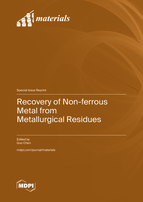Recovery of Non-ferrous Metal from Metallurgical Residues
A special issue of Materials (ISSN 1996-1944). This special issue belongs to the section "Metals and Alloys".
Deadline for manuscript submissions: closed (20 July 2023) | Viewed by 21192
Special Issue Editor
Interests: microwave heating; comprehensive utilization of metal resources; manganese ore; titanium slag; biomass reduction
Special Issues, Collections and Topics in MDPI journals
Special Issue Information
Dear Colleagues,
Non-ferrous metals and alloys are essential resources for the development of modern industries. With the depletion of natural minerals, the recovery of non-ferrous metal from metallurgical residues attracts researchers from multidisciplinary areas. Ideas of new recovering routes reduce pressures on natural resources and the environment, thus benefiting better manufacturing sustainability.
This Special Issue primarily considers papers focused on the theoretical and engineering aspects of the processing of metals recovery from metallurgical residues. We are inviting papers that include but are not limited to the original work or review article embodying the results of extensive field, plant, laboratory, or theoretical investigation, with any of the following thematic areas:
- Non-hazardous treatment of metallurgical residues;
- Novel applications of metallurgical residues;
- A novel process for the recycling of non-ferrous metals and alloys;
- Biomass pyrogenation;
- Metallurgical reaction engineering of technological processes.
Prof. Dr. Guo Chen
Guest Editor
Manuscript Submission Information
Manuscripts should be submitted online at www.mdpi.com by registering and logging in to this website. Once you are registered, click here to go to the submission form. Manuscripts can be submitted until the deadline. All submissions that pass pre-check are peer-reviewed. Accepted papers will be published continuously in the journal (as soon as accepted) and will be listed together on the special issue website. Research articles, review articles as well as short communications are invited. For planned papers, a title and short abstract (about 100 words) can be sent to the Editorial Office for announcement on this website.
Submitted manuscripts should not have been published previously, nor be under consideration for publication elsewhere (except conference proceedings papers). All manuscripts are thoroughly refereed through a single-blind peer-review process. A guide for authors and other relevant information for submission of manuscripts is available on the Instructions for Authors page. Materials is an international peer-reviewed open access semimonthly journal published by MDPI.
Please visit the Instructions for Authors page before submitting a manuscript. The Article Processing Charge (APC) for publication in this open access journal is 2600 CHF (Swiss Francs). Submitted papers should be well formatted and use good English. Authors may use MDPI's English editing service prior to publication or during author revisions.
Keywords
- metal recycling
- biomass
- microwave heating
- metallurgical residue
- comprehensive utilization of metal resources
- hazard-free treatment of industrial waste
- non-ferrous
- metallurgical process optimization
- energy saving
- carbothermic reduction







